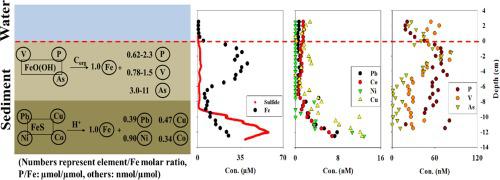Environment International ( IF 11.8 ) Pub Date : 2020-09-20 , DOI: 10.1016/j.envint.2020.106140 Chunyang Zhou 1 , Camille Gaulier 2 , Mingyue Luo 1 , Wei Guo 3 , Willy Baeyens 1 , Yue Gao 1

|
Belgian coastal sediment serves as an important sink for trace elements, yet a systematic study covering a wide range of elements including redox-sensitive metals (Fe, Mn, and Co), cationic trace metals (Cd, Pb, Ni, Cu, and Zn), oxyanions (P, V, As, and Mo), and sulfide has not been performed and the mechanisms controlling their mobilization were not investigated. Here, a passive sampling technique, Diffusive Gradients in Thin-films (DGT), was used in situ to obtain high resolution concentration profiles of these elements in the sediment porewater. Our results revealed two mobilization mechanisms of cationic trace metals and oxyanions in Belgian coastal sediments, both strongly linked to the cycling of Fe. Mobilization of Co, Pb, Ni, and Cu is controlled by electrogenic sulfur oxidation, acidification of the porewater and dissolution of FeS, while that of oxyanions (P, V, and As) is controlled by reductive dissolution of Fe oxyhydroxides. Constant cationic trace metal to Fe molar ratios were established in FeS, while the oxyanion to Fe ratios in Fe oxyhydroxides differ significantly between sampling stations, which is primarily caused by competing effects. We found no evidence that cationic trace metal mobilization was related to Fe oxyhydroxides, or oxyanion mobilization to FeS. This suggests that particulate organic matter forms the major pathway for cationic trace metal input in coastal sediments and that oxyanions will not be incorporated in FeS but form their own oxyanion-sulfide compound. These findings will contribute to a better understanding of the mobilization mechanisms of cationic trace metals and oxyanions in coastal sediments, and of their biogeochemical cycling in coastal ecosystems.
中文翻译:

比利时沿海沉积物的细尺度测量揭示了阳离子痕量金属和氧阴离子的不同动员机制。
比利时沿海沉积物是痕量元素的重要汇,但系统研究涵盖了多种元素,包括对氧化还原敏感的金属(Fe,Mn和Co),阳离子痕量金属(Cd,Pb,Ni,Cu和Zn) ),氧阴离子(P,V,As和Mo)和硫化物尚未进行,并且未研究控制其移动的机理。这里,被动采样技术,扩散梯度在薄膜(DGT),使用原位以获得沉积物孔隙水中这些元素的高分辨率浓度曲线。我们的结果揭示了比利时沿海沉积物中阳离子痕量金属和氧阴离子的两种动员机制,两者均与铁的循环密切相关。Co,Pb,Ni和Cu的动员是通过电生硫氧化,孔隙水的酸化和FeS的溶解来控制的,而氧阴离子(P,V和As)的还原性是通过羟基氧化铁的溶解来控制的。在FeS中建立了恒定的阳离子痕量金属与Fe摩尔比,而在各采样站之间,羟基氧化铁中的氧阴离子与Fe的比例存在显着差异,这主要是由竞争效应引起的。我们发现没有证据表明阳离子痕量金属的动员与羟基氧化铁或氧阴离子对FeS的动员有关。这表明颗粒状有机物构成了沿岸沉积物中阳离子痕量金属输入的主要途径,并且氧阴离子不会掺入FeS中,但会形成其自身的氧阴离子-硫化物化合物。这些发现将有助于更好地理解沿海沉积物中阳离子微量金属和氧阴离子的动员机制,以及沿海生态系统中它们的生物地球化学循环。



























 京公网安备 11010802027423号
京公网安备 11010802027423号